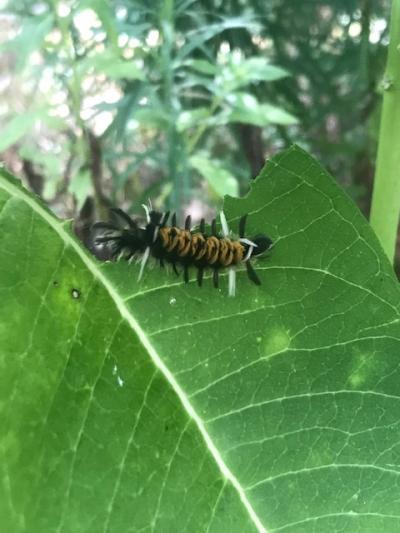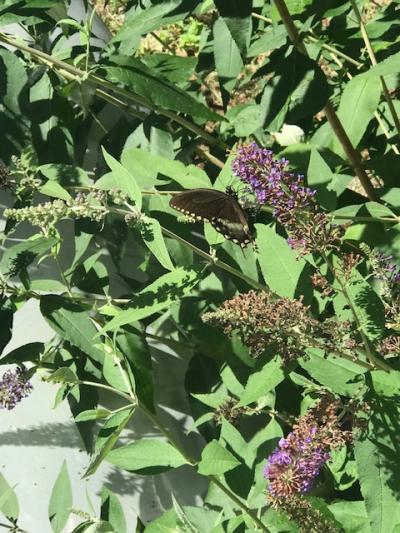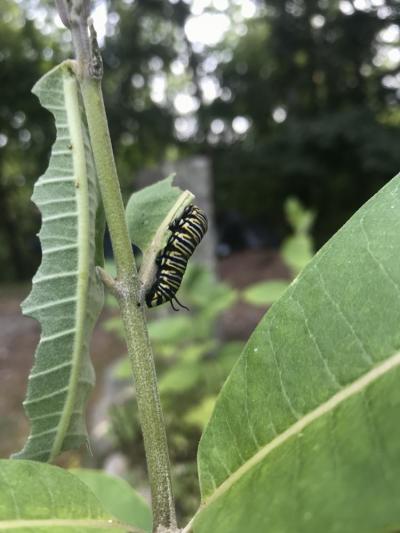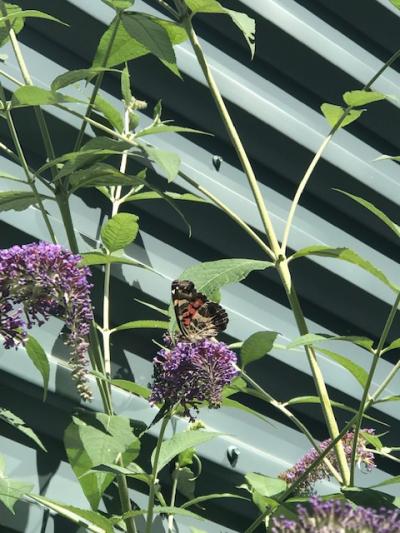Lloyd Center Wildlife Adapts to Drought Conditions by Jamie Bogart, Lloyd Center Research Associate
As late summer rolls in, the “dog days” end, and we divert our attention away from the beach; we observe an interior landscape in flux. Birds are migrating while insects are jumping between plants or flowers. Some birds have messy plumages in mid-molt (including our screech owl) and fledges attain their first feathers, while insects are in their own metamorphosis from larval stage to flighted adults. A year ago, bird feeders were down due to avian flu concerns, while this year unprecedented drought has left the landscape thirsty. But wildlife adapts and local biodiversity is just sharing real estate.
Around our property, the presence of butterflies is a welcome sign that life has gone on despite impaired herbaceous growth. Many species have been observed visiting our parched butterfly bushes forced to share the same flower including Tiger Swallowtail, both Black and Spicebush Swallowtail, American Lady, the Cabbage Butterfly, and the familiar Monarch, a similar assemblage mentioned a year ago. These species are searching for food in various open habitats, and our mix of open woods, edge, and butterfly garden habitats, provide various options for many Lepidoptera species.
Monarchs, now considered more endangered than ever due to habitat loss in their wintering grounds in New Mexico, obviously deserve their own category as a fall tagging program focus, and as emblematic of a unique life cycle. Multiple generations of Monarchs pass through our region, including like last year a robust July wave, with the transformation of larval through caterpillar then pupal (cocoon) stage which is underway now. Striking caterpillars, which are brightly colored to alert predators that they’re poisonous, are a familiar sight on milkweed plants upon which they feed, and seem to be more abundant than last year. The Milkweed Tussock moth caterpillar also feeds on this important plant that has withstood dry conditions and served as an important Lepidoptera food plant.
For bird life on the Lloyd Center property, the feeders are active with finches, including American Goldfinches in various shades of yellow, and House Finches, both species recently active feeding on seeds of dune vegetation at many beaches. A decisive finch wave occurs each summer as these birds race to the closest seed crop. Blackbird species including redwings, grackles, and Brown-headed Cowbirds, are also filing in along with familiar feeder species (chickadees, titmice, nuthatches, etc.) which return to feeders now that nesting is complete.
Recent sightings of birds not normally associated with feeders are Yellow Warblers and Great Crested Flycatchers, with these species passing through in migration for a bite or drink as birds gather in “foraging flocks” of multiple species. Our bird bath is getting attention of course, with birds likely faring better through the drought as treetop feeders. Avian diversity will increase in the weeks ahead as forest birds, like the shorebirds, enter migration mode, and the bird bath will likely be busy.
While feeders can attract unwanted guests (such as our sneaky raccoon), depending on location, use by mammals is also part of having a feeder station. Chipmunks and squirrels are busy gathering seeds at ground level, and a deer even walked up for a bite. Deer are quite active browsing or taking a drink at the local estuary (since the drought has dried up their “watering holes”) and can be seen on most visits to the Lloyd Center trails.
The shoreline has beauty in all seasons and now bustles with avian activity. But as the temps slowly cool and the rains eventually fall, the inner landscape will continue to come alive with much to see, away from the beach we’ve been glued to for so many months.















